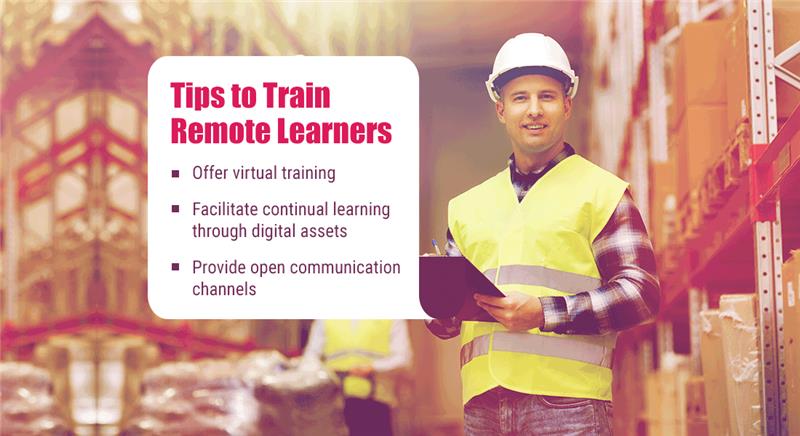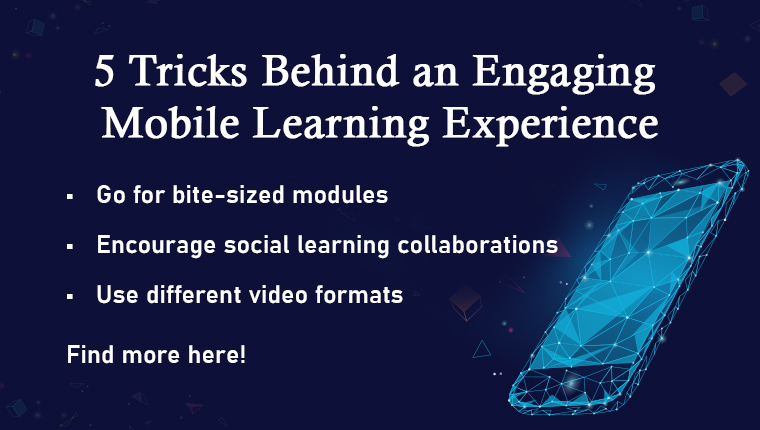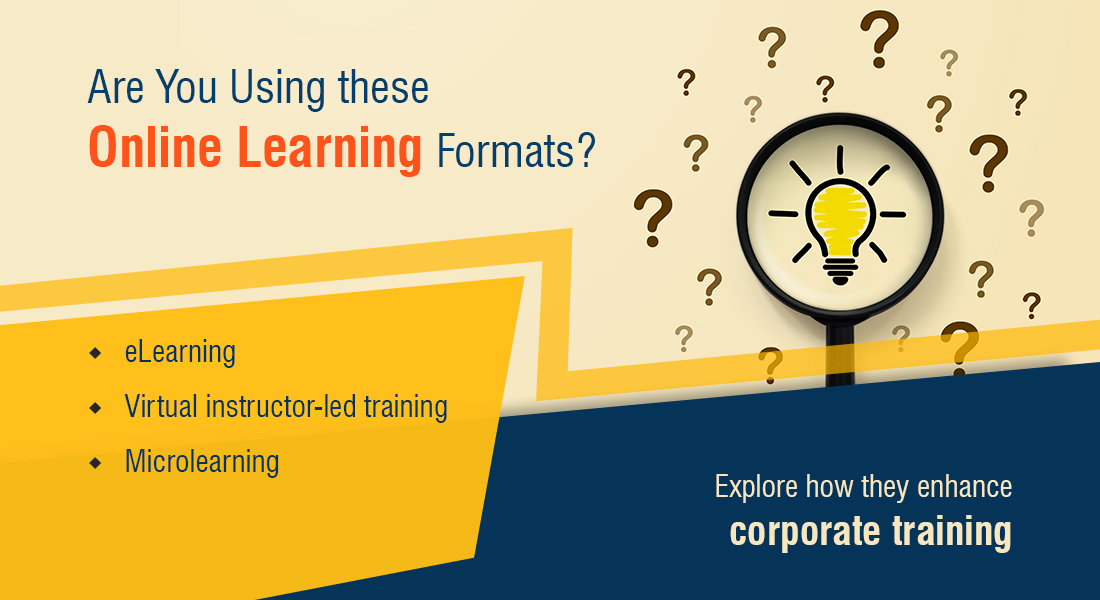5 Tips to Create an Impactful Remote Learning Experience
Remote learning is a must-need for modern global corporate workforces. It allows learners access to training irrespective of their geographical location. Here is a blog to help you create impactful remote learning.

The coronavirus pandemic has made remote learning the new normal. But is remote learning as effective as the conventional classroom where there is actual face to face interaction between the learners and trainer? Are you worried that your learners may not reap the full benefits of employee training in a remote learning setting? This blog will give you five concrete tips to maximize the remote learning experience.
How to go about Creating Impactful Remote Learning
- Make training available on a virtual platform
- Offer digital learning assets for continuous learning
- Ensure open communication channels for all
- Ensure smooth transition to eLearning technology
- Acknowledge learner achievements and provide quick feedback
In an ideal scenario, most employee training would be face-to-face – with the trainer having a clear idea about the number of learners, their knowledge level, the learning content, anticipated questions, and how to respond to them. But now is hardly the time for ideal scenarios. The classroom has shifted to eLearning where the instructor does not interact physically with the learners, not any more. However, until the time conventional ILT sessions reclaim their place in employee training, here are five tips to create a more impactful remote learning experience.
5 Tips to Maximize Remote Learning Outcomes
1. Make Training Available on a Virtual Platform
Two training strategies that become quite relevant here are VILT (Virtual Instructor Led Training) and eLearning. A VILT session replicates a typical classroom session, only in a virtual environment. This can be made possible through apps such as Skype, Microsoft Teams, Adobe Connect and Zoom, where apart from seeing each other’s faces, one can also share a screen (play a video or a PowerPoint) with the participants.
What’s more, most of these conferencing apps also allow breakout rooms – smaller sessions split from the main session where participant groups can meet and discuss in an entirely separate audio-visual space, then come back to rejoin the main meeting.
Besides VILT, which is synchronous, asynchronous eLearning can come in handy for remote learning.
- Unlike VILT, eLearning is can be accessed anytime by learners at their convenience.
- Most eLearning courses can be accessed on handheld devices without the content being disrupted.
- Interactive learning and gamification can be included in eLearning for increased learner engagement and motivation.
So VILT, or eLearning, or a bit of both – the choice is yours. Trust me, both work wonders in remote corporate training.
2. Offer Digital Learning Assets for Continuous Learning
Remote learning depends a lot on the availability of digital resources and technologies. Ensuring a steady supply of digital learning assets can be a game changer when it comes to maximizing your remote learning.
Here’s how continuous learning works in tandem with digital learning assets:
- Learning on-the-go: Digital learning assets like eBooks and PDF documents, watch-and-learn videos, audio books and podcasts can make continuous learning feasible.
- Learning with efficiency: All digital learning assets can be made accessible within the LMS ensuring learning as well as tracking of learning.
- Learning small and concise: Microlearning modules can be used for remote training with more concise content. Device-based learning also facilitates on-demand learning.
3. Ensure Open Communication Channels for All
Many learners tend to lose out on important training sessions simply because of a lack of communication between them and the instructor.
This is how you can facilitate better communication:
Promote socialization through technology: Social learning through digital learning environments (real-time conversations like instant messaging and discussion boards for exchanging ideas and thoughts) is the most basic channel for communication between learners, trainers, SMEs, managers, and others.
Hold frequent team meets and discussions: Queries form a large portion of learning. In remote learning, it is prudent to have more frequent discussion sessions and virtual meets over Skype or Zoom to address learners’ queries.
Form social media groups and teams: It is difficult to keep track of all learners on a virtual platform. An online group, like a WhatsApp or a Skype group can be a recipe for success. Not only does it provide a unified platform for all, but also ensures that everyone gets an opportunity to raise and resolve queries.
Encourage active social learning: Encourage your learners to be active participants in the learning process so that they can also contribute to the learning process. This can be something as simple as sharing how-to demos and examples between learner groups, to asking more queries.
Prioritize communication between instructors and learners so that learners are kept abreast on the training and also on the workings of the organization. Better communication also ensures that learners inform trainers about the issues that they are facing while learning remotely.
4. Ensure Smooth Transition to eLearning Technology
Technology is at the core of any remote learning strategy. A strong Internet connection, although a requirement, cannot always be guaranteed. This is why a large part of remote learning happens through a variety of ways, including webinars, eLearning courses, tailored videos and podcasts, interactive hands-on applications, and mobile learning.
Ensure a smooth transition from ILT to remote learning sessions, so that your learners, especially if they are digital immigrants, can start reaping the benefits of remote learning from day 1. The following are a few things that you can do:
Bring all the learners on the same page during orientation, stressing upon the main objectives of the training, and also on the ‘how-to’s of the virtual training process, from training platforms and social media groups to dedicated LMSs and digital content.
Train them on how to use virtual assets like a Learning Management System, or virtual learning platforms, as well as how to access learning materials, post discussions, comments, deal with assessments, check reports and reviews etc. Most LMS or learning tools come with their own tutorials. Host sessions where learners can be trained using those tutorials, on how to use the technology.
Provide examples and demos to make the training process simpler. Also make sure that an expert is present to help learners who are finding it difficult to understand.
Meanwhile, it is equally important to train the trainers on the nuances of the training platforms and LMS that they will be using. This includes training on hosting a session, forming and dispersing breakout rooms in a group chat, uploading learning resources, posting and reviewing assessments, providing feedback and rewards, etc.
Having your learners shift seamlessly from regular classroom to a remote learning environment will help ensure better learning outcomes. Having your trainers experience the same ensures that your learners are in capable hands.
5. Acknowledge Learner Achievements and Provide Quick Feedback
If you are not familiar with the concept of Operant Conditioning, it basically states that learners perform better in a desired task when adequate positive reinforcement or reward is provided.
Remote learning for corporate learners can be daunting, with many of them believing in some common myths surrounding virtual classrooms and online training. Acknowledging their achievements is the best way to tell them that they are on the right path.
Here are a few pointers on how to do it right:
- Posting simple positive feedback like ‘good job’ and ‘well done’ on discussion boards can act as micro motivators for the learners.
- Feedback and appreciation sent as messages, along with reviews of the progress can act as a performance booster, telling the learners what needs to be worked on.
- Prompt and consistent feedback ensures retention of learned content. However, avoid reprimanding or negatively reinforcing the learners, which can be demotivating.
- Gamification features within the LMS, like leaderboards, skill points, level-ups, and reward rankings, can be used to display learners’ achievements. This helps motivate and encourage learners, while also adding a dash of healthy competition in the mix.
Summing it Up!
Yes, remote learning can be a completely new cup of beverage for a lot of people, but at the end, the outcomes of remote learning are highly dependent on how you, as a training manager, ensure its effectiveness. The five tips discussed here will help you provide a more impactful remote learning experience.
If all your training responsibilities are weighing down on you, you can always go for outsourcing your eLearning development to a trusted vendor. Here is an eBook to provide a comprehensive guide for eLearning outsourcing.





